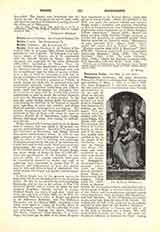

Borgia, STEFANO, Cardinal, b. at Velletri, December 3, 1731; d. at Lyons, 1804; Italian theologian, antiquarian, and historian. He belonged to a well-known family of Velletri, not to be confounded with the Spanish Borgias or Borjas. His early education was controlled by his uncle Alessandro (1682-1764), Archbishop of Fermo. From his youth, Stefano Borgia manifested a great aptitude for historical research, but his dominant trait was his extraordinary taste for relics of ancient civilizations, a line in which he succeeded so well that, at the age of nineteen, he was received into the Academy of Cortona. He founded a museum at Velletri, in which, during his whole life, he gathered coins and manuscripts, especially Coptic, and which may be considered as his greatest undertaking and achievement. Such was his passion for antiquities that he is known to have sold his jewels and precious earthenware in order to secure the coveted treasures and have the description of them printed. In his scientific career Borgia showed great disinterestedness, placing his collection at the disposal of learned men, regardless of creed and country, and giving them all possible encouragement and support. His amiable temperament and broadminded character attracted to him all those with whom he came in contact; Paolino da S. Bartolomeo, Adler, Zoega, Heeren, and many others were among his enthusiastic friends.
Borgia was not left, however, entirely to his chosen field of activity, but was called to fill several important political positions. Benedict XIV appointed him Governor of Benevento, and Borgia showed there great administrative talent. In 1770 he was made secretary of the Congregation de Propaganda Fide, an office of which he naturally took advantage to acquire antiquities by the help of the missionaries, a help, be it said to their credit, which proved always forthcoming. He was made a cardinal in 1789. In the troubled period of the French invasion Borgia was given charge of Rome by Pius VI (1797-98). After the proclamation of the Republic, he was arrested (1798), but quickly released, whereupon he immediately resumed his studies and work of collecting; soon afterwards he joined Pius VI at Valencia, and endeavored to have this pontiff send to Asia and Africa a body of missionaries who would preach the Gospel and gather various monuments.
Cardinal Borgia was of the greatest service to Pope Pius VII in the reorganization of the Pontifical States. In 1801 he was made Rector of the Collegium Romanum, and he was in the retinue of Pius VII when this pontiff went to France to crown the new emperor, Napoleon. Having arrived at Lyons, Cardinal Borgia was taken ill and died. After his death his collection of Coptic MSS. was divided: the non-Biblical MSS. were taken to Naples and placed in the Biblioteca Borbonica, now the Biblioteca Nazionale; and the Biblical MSS., excepting a few which were taken to Naples by mistake, given to the Propaganda, together with the collection of coins and monuments, forming the Museo Borgiano. (Cf. Ciasca, Fragmenta Copto-Sahidica, I, p. xvii.) Only a few years ago the MSS. of the Museo Borgiano were transferred to the Vatican library, where they are to be found today. Before the partition of the MSS. was made the eminent scholar and convert, Zoega, wrote a complete and accurate description of them in his posthumous work “Catalogus Codicum Copticorum manu scriptorum qui in Museo Borgiano Velitris adservantur” (Rome, 1810). Besides the many services which Cardinal Borgia rendered to science and scientists, he published several works bearing especially on historical topics: “Monumento di papa Giovanni XVI” (Rome, 1750); “Breve istoria dell’ antica citta di Tadino” (ibid., 1751); “Memorie storiche della citta di Benevento” (ibid., 1763-69); “Vaticana confessio B. Petri chronologicis testimoniis illustrata” (ibid., 1776); “De Cruce Vaticana” (ibid., 1779); “De Cruce Veliterna” (ibid., 1780); “Istoria del dominio temporale della Sede Apostolica nelle Due-Sicilie” (ibid., 1788).
R. BUTIN

